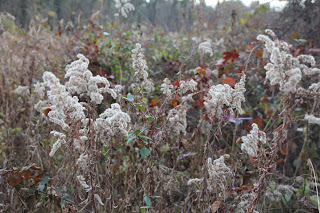 |
| Asian bittersweet's (Celastrus orbiculatus) irresistible yellow carpels and red fruits tempt wreath makers, who then discard their handiwork after the holidays, thus helping to spread this menace. |
When we entered the woods and immediately came upon a red oak (Quercus rubra) brought down across the trail by Hurricane Sandy. Though the staff had cleared the canopy of the oak out of the path, the limbs, branches and trunk remained.
 |
| The downed red oak trunk sprawled across the forest floor |
 |
| Red oak - dismembered |
 |
| At the woods-meadow edge, the white pine saplings were damaged by bucks rubbing their stems and eating their tender tops. Must give them piney fresh breath! |
 |
| Goldenrod (Solidago spp.) in seed |
 |
| Indian-hemp (Apocynum cannabinum) seeds |
 |
| Horse-nettle (Solanum carolinense), a weedy, prickly native member of the tomato family |
When we left the wet meadows, crossing the Eagle Scout footbridge across the gully, I looked downstream. Normally, the sight line is limited by a tangle of nearly impenetrable vegetation, but with the onset of autumn many of the plants had lost their leaves, revealing a pool and high, rocky banks adorned with Christmas ferns (Polystichum acrostichoides).
 |
| American Hornbeam (or Musclewood, or Blue-beech, or Ironwood) (Carpinus carolinense) helping to stabilize the gully's bank. |
 |
| November in the beech woods |
With the leaves gone from the native spicebush (Lindera benzoin) shrub layer, it has become obvious that the shrub layer is not all spicebush but also includes a healthy population of invasive, non-native jetbead (Rhodotypos scandense )that, like many non-native plants, holds its leaves longer than the natives. Such a strategy gives the invasives a competitive advantage over the natives because they can photosynthesize longer than the natives.
As the group rounded a corner in the trail, we came across a large white oak (Quercus alba) uprooted by Hurricane Sandy. If you look closely at the left side of the image, you'll see that that the oak toppled into a neighboring tree, uprooting that tree as well like two tumbling dominoes.
 |
| A hard, dessicated, mahogany-colored fungus at the base of an oak tree |
 |
| Termite-riddled base of the Pileated Woodpecker Tree |
 |
| Pileated Woodpecker Tree |
 |
| On close inspection, we discovered that fungi had colonized the tree, and had begun to emerge through cracks in the bark - like fiery lava oozing out of the earth! |
 |
| Blackberry (Rubus sp.) in regal purple |
 |
| Kali helping to disperse milkweed seeds. This is among her favorite autumn activities, and helps to perpetuate milkweeds - and Monarchs! |
 |
| Silvery samaras of a box-elder (Acer negundo) at the head of the gully |
 |
| Botanizing at the edge of the meadow |
The final leg of the trail passes along the center of a long double allee of white pines (Pinus strobus) planted in the 1920s. Two of these pines lost major limbs during Hurricane Sandy, both of which came down across telephone and cable lines. The telecommunication lines never snapped, but the limbs bowed them down to the ground. These were among the last tree (parts) cleared off utility lines in our area because, unlike electricity, they were not essential and because the serve had not been interrupted.
 |
| One of the damaged white pines |
 |
| Final vista across the late autumn fields |










6 comments:
As always, Scott, a highly informative and enjoyable blog. How many trails in the preserve? I really like the photos here, and the writing, as per usual, is strong. You even got to use the word "penultimate." Doesn't get any better than that.
Happy Thanksgiving to you and Kali.
Hi and "thank you" again for a beautiful and informative walk along your trails. The fungi are amazing. I so enjoyed walking with you and your group - I could see and feel and hear and smell and absorb every glorious moment.
Love Gail
peace.....
Packrat: Thanks for your compliments; I really appreciate them. The preserve has a dozen trails, and they ranging in length from about 1/4-mile to well over a mile. The shorter ones wouldn't do for a guided walk, but the longer ones certainly would lend themselves to a nice ramble.
Gail, I certainly wish that you could join us! I'll do my best--at least one more time--to impart the "feel" of the trail--next time in December. Welcome aboard.
It is quite lovely to virtually take these hikes with you and your fellow hikers. I like the idea of a monthly hike to record the changes. The photos are so beautiful. I've been reviewing my photos of the past few years, and started noticing repeating patterns even of the timing of the iridescent clouds.
Thank you, Robin Andrea. Kali asked me what insights I've gained after walking the same path over a year's time. I don't have any grand revelations to share, only small surprises that I try to include in my accounts of each walk.
Post a Comment